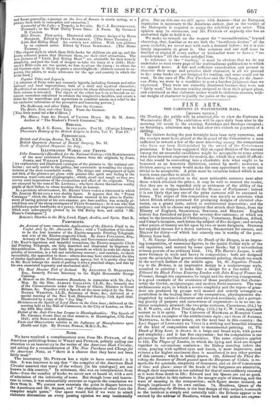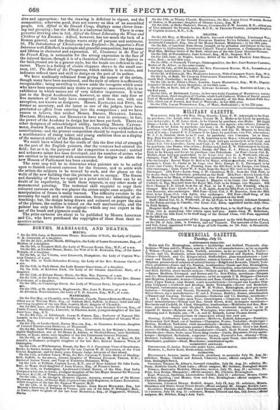FINE ARTS.
THE CARTOONS IN WESTMINSTER HALL.
[SECOND NOTICE.]
ON Monday, the public will be admitted free to view the Cartoons in Westminster Hall. The exhibition will be open daily from nine in the morning till seven in the evening, Saturdays and Sundays excepted; on Saturdays, admission may be had after two o'clock on payment of a shilling.
The visiters during the past fortnight have been very numerous, and the receipts must have placed at the disposal of the Commission a sum sufficient to reward a few of the most deserving among the competitors who have not been distinguished by the award of the Government premiums. It has been suggested that an equal division of the amount among the unsuccessful candidates might be acceptable to some artists who have incurred expenses for models, &c. which they could ill afford: but this would be converting into a charitable dole what ought to be bestowed as an honorary distinction, earned by merit : moreover, a division among so many would make the sum apportioned to each too trivial to be acceptable. A prize must be valueless indeed which is not worth some sacrifice to attain it.
Before calling attention to the most noticeable cartoons next after
those which obtained the prizes, it may be well to remind the reader, that they are to be regarded only as evidences of the ability of the artists, not as designs intended for the Houses of Parliament : indeed it is not likely that any one of the prize cartoons will be executed in fresco. The object of this competition was merely to ascertain what talent British artists possessed for producing designs of elevated cha- racter, on a grand scale, suited to architectural decoration ; and the artists were left to choose any subjects that struck their fancy, from the History of England, SHAIESPERE, SPENSER, and MILTON. English history has furnished subjects for seventy-five cartoons; of which ten relate to the introduction of Christianity ; Caractacus, Boadicea, Alfred, and Ctesar's invasion, each forms the subject of five designs ; and several other points of history are hit upon by two or more designers. SPENSER has supplied themes for a dozen cartoons, SHAKSPERE for sixteen, and MILTON for thirty—of which last scarcely one is worthy of the poet: History fares best. 7, St. George Immediately after the Death of the Dragon, is an impos- ing composition, of numerous figures, in the quaint Gothic style of the old tapestries, and marred by some queer heads ; but it nevertheless evinces powers of no ordinary kind. 110, The Baron's League, is still more German in style and heavy in composition : both are designed upon the principles that govern monumental painting, though too much in the uncouth fashion of the middle ages. 92, St. Augustine Preach- ing to the Britons, is an impressive design in a sculpturesque style, unsuited to painting : it looks like a design for a bas-relief. 118, Edward the Black Prince Entering London with John King of France his Prisoner, though the expression be turgid and the drawing exaggerated, is a good example of the avoidance of those peculiarities that charac- terize the Gothic, sculpturesque, and modern florid manners. The true architectonic style, in which a severe simplicity and the repose of gran- deur are produced by groups well massed and orderly arranged—a parallelism in the leading lines of the composition, physiognomies dis- tinguished by national character and elevated sentiment, and a pervad- ing gravity of purpose and earnestness of expression—is in no one in- stance completely attained : the two prize cartoons, Caractacus, (84,) by. G. P. Werra, and First Trial by Jury, (105,) by C. W. COPE, approach nearest to it in spirit. The Cartoons of RAPHAEL at Hampton Court are the finest examples of the architectonic style ; and those of ANDREA MA NTECINA, in the same palace, are the next best in this country : the Last Supper of LEONARDO DA ViNCI is a striking and beautiful instance• of the kind of composition suited to monumental painting. 16, The Death of King Lear, is drawn in a large and broad style, with power and simplicity ; and it has fine expression: but the composition is too picturesque for architectural decoration. The same objection applies to 122, The Plague of London, in which the dying and dead are heaped together in ostentatious confusion : the Bishop standing before the cross, praying with uplifted eyes and hands, is most impressive, and evinces a far higher sentiment than is manifested in any other portion of this cartoon ; which is boldly drawn. 120, Edward the Third Re- voking the Sentence of Death passed upon the Burgesses of Calais, is re- markable for quietude, simplicity of treatment, and an air of remoteness of time and place: some of the heads of the burgesses are admirable, though their expression is too subdued for that of mensuddenly restored as it were from death to life: Edward and his Queen are not so good. The great defect in this cartoon is the meagre style of drawing, and the want of massing in the composition ; each figure seems isolated, as though imprisoned in its own outline. 74, Boadicea, Queen of the Iceni, Animating the Britons, is the best design of this subject, inasmuch as the incident is simply and naturally told: the Britons appear to be excited by the addreas of Boadicea, whose look and action are expres-
sive and appropriate : but the drawing is deficient in vigour, and the composition, otherwise good, does not convey an idea of an assembled
people. 103, Alfred in the Danish Camp, displays some clever draw- ing and grouping ; but the Alfred is a ludicrous failure. There is some powerful drawing also in 102, Alfred the Great Liberating the Wives and Children of his Enemies : Alfred, however, has too much the look of a Roman general, and the design wants unity of purpose and sentiment. 98, 77te Introduction of Christianity into England—St. Augustine's First Interview with Ethelbert, is a simple and graceful composition, but too tame and lifeless in character and expression. 27, Constance in the Tent of the French King, is noticeable for the strong expression in the face of the injured Queen, though it is of a theatrical character : the figures in the background are in a graver style, but the heads are deficient in cha- racter. There is a feeling of classic elegance shown in the small car- toon, 137, The Bark of the Prosperous, which entitles it to notice, and indicates refined taste and skill in design on the part of its author.
We have studiously refrained from giving the names of the artists, though many have been mentioned, and the style of others is sufficiently recognizable ; being unwilling to throw aside the incognito which some who have been unsuccesful may desire to preserve : moreover, this is an exhibition in which names are of very inferior importance. It is but jest to the- Royal Academicians, however, to state that only four or five members of that body have competed ; and these are, with one exception, not known as designers. Messrs. EASTLAKE and Erry, the former as secretary, and the latter as one of the judges, have been
precluded ex officio from entering into the competition ; and we have reason to believe, that neither Messrs. Bamos, HERBERT, LESLIE,
MACLISE, MULREADY, nor REDGRAVE have sent in cartoons : in fact, the power of the Academy in design has not been put forth. There are other designers of acknowledged ability, including Messrs. CATTER-
MOLE, JosEPH Nests, and FREDERICK TAYLER, who have withheld their contributions ; and the present competition should be regarded rather as a manifestation of rising talent and young ambition than as a display of the matured ability of the British school.
We could have wished for the credit of this the first trial of strength on the part of the English painters, that the veterans had entered the field; but as it is, the purpose of the competition is answered : untried and unknown talent has been developed, and the number of artists who are entitled to be intrusted with commissions for designs to adorn the new Houses of Parliament has been extended.
The next step will be to determine what painters are to be called upon to furnish coloured cartoons for the frescoes, and to settle with
the artists the subjects to be treated by each, and the places on the walls of the new building that the pictures are to occupy. The fitness and durability of fresco we regard as a point settled : there can be no doubt of its superiority, in both these respects, to any other mode of monumental painting. The technical skill requisite to copy their coloured cartoons on the wet plaster the artists might soon acquire: the manipulation of fresco is easily learned. The difficulty consists in the necessity for rapid and certain execution, fresco not admitting of re- touching; but, the design being drawn and coloured on paper the size of the picture, the outline is traced on the wall mechanically, and the painter has only to follow his original—which any one expert in the use of the brush and pigments could do. The prize cartoons are about to be published by Messrs. LONGMAN and Co., who have purchased the copyrights of them from their re- spective artists.



























 Previous page
Previous page